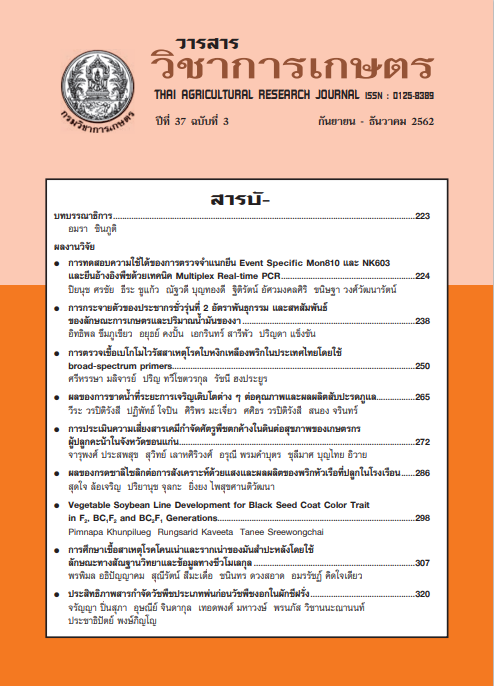การประเมินความเสี่ยงสารเคมีกำจัดศัตรูพืชตกค้างในดินต่อสุขภาพของเกษตรกร ผู้ปลูกคะน้าในจังหวัดขอนแก่น
DOI:
https://doi.org/10.14456/thaidoa-agres.2019.23คำสำคัญ:
ความเสี่ยงจากสารเคมีกำจัดศัตรูพืช; การปฏิบัติทางการเกษตรที่ดี; ค่าดัชนีบ่งชี้อันตรายบทคัดย่อ
งานวิจัยนี้มีจุดประสงค์เพื่อศึกษาการปฏิบัติทางการเกษตรที่ดี (GAP) ต่อความเสี่ยงจากสารเคมีกำจัดศัตรูพืชตกค้างในดินที่มีต่อสุขภาพของเกษตรกร ได้ศึกษาระดับครัวเรือนโดยเลือกหมู่บ้านที่เกษตรกรมีอาชีพปลูกผักเชิงพาณิชย์ในพื้นที่ อ.เมือง จ.ขอนแก่น จำแนกเกษตรกรในหมู่บ้านเดียวกันเป็น 2 กลุ่ม คือ เกษตรกรที่ร่วมโครงการ GAP และเกษตรกรที่ไม่เข้าร่วมโครงการ GAP (non-GAP) โดยเลือกตัวอย่างเกษตรกรแบบเฉพาะเจาะจงกลุ่มละ 10 ราย ใช้วิธีการสำารวจแปลงและสัมภาษณ์ ร่วมกับการวิเคราะห์ทางห้องปฏิบัติการประเมินความเสี่ยงสารพิษตกค้างในดินด้วยค่าดัชนีบ่งชี้อันตราย (Hazard Index, HI) ทำการศึกษาระหว่างเดือน มีนาคม-พฤษภาคม 2561 โดยเก็บตัวอย่างดินแปลงปลูกคะน้าแปลง GAP และnon-GAP ในระยะเก็บเกี่ยว จำนวน 20 แปลง นำมาตรวจวิเคราะห์สารเคมีกำจัดศัตรูพืช จำนวน152 ชนิดสารด้วยเครื่อง LC-MS/MS ผลการศึกษาพบว่า ดินแปลงปลูกคะน้าทั้ง GAP และ non-GAP พบสารพิษตกค้างทุกแปลง ชนิดสารพิษที่ตรวจพบในแปลง GAP มีจำนวน 7 ชนิดสาร ได้แก่ alachlor carbosulfan chlorantraniliprole cypermethrin imidacloprid metalaxyl และ profenofos ขณะที่ตัวอย่างดินจากแปลง non-GAP พบสารพิษ 14 ชนิดสาร ได้แก่ acetamiprid acetochlor alachlor carbaryl carbosulfan chlofenapyr chlorantraniliprole chlorpyrifos cypermethrin dinotefuran imidacloprid indoxacarb profenofos และ tofenpyred การประเมินความเสี่ยงต่อสุขภาพด้วยค่า HI พบว่า เกษตรกรจากแปลง non-GAP มีค่าเฉลี่ย HI เท่ากับ 2.02 x 10-4 ขณะที่เกษตรกรแปลง GAP มีค่าเฉลี่ย HI เท่ากับ 0.36 x 10-4 เป็นค่าที่น้อยกว่า 1 ซึ่งอยู่ในเกณฑ์ยอมรับได้ อย่างไรก็ตามเนื่องจากความถี่การตรวจพบสารเคมีกำจัดศัตรูพืชตกค้างในดินแปลง non-GAP มากกว่าแปลง GAP ดังนั้นเกษตรกร non-GAP จึงมีโอกาสได้รับสารพิษเข้าสู่ร่างกายมากกว่าเกษตรกร GAP
เอกสารอ้างอิง
กรมวิชาการเกษตร. 2554. เอกสารสนับสนุน ระบบการจัดการคุณภาพ: GAP พืช การเก็บตัวอย่างดินเพื่อการวิเคราะห์. กระทรวงเกษตรและสหกรณ์. กรุงเทพฯ.
กรมวิชาการเกษตร. 2562. ระบบ GAP online. กรมวิชาการเกษตร กระทรวงเกษตรและสหกรณ์(วันที่สืบค้น 10 เมษายน 2562) จาก: URL. http://gap.doa.go.th/
กระทรวงเกษตรและสหกรณ์. 2560. แผนยุทธศาสตร์การจัดการสารเคมีทางการเกษตรปี 2560-2561 ข่าวทำเนียบรัฐบาล, กระทรวงด้านเศรษฐกิจ วันที่ 9 กุมภาพันธ์ 2560. (วันที่สืบค้น 10 พฤษภาคม 2560) จาก :http://thaigov.go.th/news/contents/details/1797.
กรมส่งเสริมการเกษตร. 2551. คู่มือนักวิชาการส่งเสริมการเกษตร. พืชตระกูลกะหล่ำ คะน้า ผักกาดกวางตุ้ง. สำนักส่งเสริมและจัดการสินค้าเกษตร กรมส่งเสริมการเกษตร กระทรวงเกษตรและสหกรณ์ กรุงเทพมหานคร
กรมส่งเสริมการเกษตร. 2560. ระบบสารสนเทศการผลิตทางด้านเกษตร Online กรมส่งเสริมการเกษตร กระทรวงเกษตรและสหกรณ์ ตัดยอดข้อมูลตามระบบ ณ วันที่ 5 กรกฎาคม 2560 (วันที่สืบค้น 1 พฤษภาคม 2562) จาก: http://production.doae.go.th.
คณะกรรมการแห่งชาติว่าด้วยการพัฒนายุทธศาสตร์การจัดการสารเคมี. 2554. แผนยุทธศาสตร์การจัดการ
สารเคมีแห่งชาติ ฉบับที่ 4 (พ.ศ. 2555-2564) ศูนย์พัฒนานโยบายแห่งชาติด้านสารเคมี สำนักงาน
คณะกรรมการอาหารและยา กระทรวงสาธารณสุข. กรุงเทพฯ.
สำนักงานมาตรฐานสินค้าเกษตรและอาหารแห่งชาติ [มกอช.]. 2551. วิธีชักตัวอย่างเพื่อตรวจหาสารพิษตกค้าง. มาตรฐานสินค้าเกษตรและอาหารแห่งชาติ. 9025-2551. กระทรวงเกษตรและสหกรณ์. กรุงเทพฯ.
สำนักงานมาตรฐานสินค้าเกษตรและอาหารแห่งชาติ [มกอช.]. 2556. การปฏิบัติทางการเกษตรที่ดีสำหรับพืชอาหาร. มาตรฐานสินค้าเกษตร มกษ. 9001-2556. กระทรวงเกษตรและสหกรณ์. กรุงเทพฯ.
Anastassiades, M., Lehotay, S.J., Stajnbaher, D. and F.J. Schenck. 2003. Fast and easy
multiresidue Method employing acetonitile extraction/partitioning and “Dispersive Solid-Phase Extraction” for the determination of pesticide residues in produce, J. AOAC Int. 86: 412 – 431.
British Standards [BSI]. 2008. Foods of plant origin –Determination of pesticide residues using
GC-MS and/or LC-MS-MS following acetonitrile extraction/ partitioning and clean up
by dispersive SPE- QuEChERS-method. BS EN 15662:2008. BSI Group, Chiswick High
Road, London, UK.
EXTOXNET. 1998. Toxicology Information Briefs (TIBs) Available from:
http://extoxnet.orst.edu/tibs/ghindex.html. Accessed. February 1, 2018.
FAO. 2016. Evaluation of pesticide residues for estimation of maximum residue levels and calculation of dietary intake. Training manual, FAO Plant Production and Protective Paper 224. Food and Agricultural Organization of the United Nation. Rome, Italy.
FAO. 2003. Development of a Framework for Good Agricultural Practices. COAG/2003/6.
COMMITTEE ON AGRICULTURE. Seventeenth Session. Rome, 31 March-4 April 2003.
FAO/WHO. 2016. Codex Pesticides Residues in Food Online Database. Maximum Residue Limits. Codex Alimentarius Commission up to and including its 39th Session (July 2016). Viale delle Terme di Caracalla 00153 Rome, Italy.
Farina, Y., Abdullah, M. P., Bibi N. and W. M. A. W. M. Khalik. 2016. Pesticide Residues in Agricultural Soil and Its Health Assessment for Humans in Cameron Highland Malaysia. Malaysian Journal of Analytical Sciences, 20(6): 1346 – 1358.
Hanson, B., Hallman, A., Bond, C. and J. Jenkins. 2017. Pesticide Binding Affinity Fact Sheet; National Pesticide Information Center, Oregon State University Extension Services. Available from. http://www npic.orst.edu/factsheets/bindingaffinity.html. Accessed. March 8, 2019.
Harnpicharnchai, k., Chaiear, N. and L. Charerntanyarak. 2013. Residues of Organophosphate Pesticide Used in Vegetable Cultivation in Ambient Air, Surface Water, and Soil in Bueng Niam Sub district, Khon Kaen , Thailand. Southeast Asian J trop Med public health. Nov; 44 (6): 1088 – 1097.
Javier, E. M. M. 2015. The GAP program and its effects on pesticide use in
Damnoen Saduak, Ratchaburi, Thailand. Thesis or Dissertation. Kyoto University. Issue
Date 2015-03-23.
Kahan, D. 2008. Managing Risk in farming. FAO. Available from: http://www.fao.org/uploads
/media/3-ManagingRiskInternLores.pdf. Accessed. February 1, 2017.
Kumar, B., Verma, V.K., Mishra, M., Gaur, R., Kumar, S. and C.S. Sharma. 2014. DDT and HCH (Organochlorine Pesticides) in residential soils and health assessment for human populations in Korba, India. Human and Ecological Risk Assessment: An International Journal, 20: 1538 – 1549.
NPIC. 2016. Pesticides and the Environment. National Pesticide Information Center. Available from: http://npic.orst.edu/envir/efate.html. Accessed. July 7, 2018.
Pesticide Action Network. 2016. PAN Pesticide database –chemicals. Available from:
http://www.pesticideinfo.org. Accessed. July 7, 2018.
Praneetvatakul, S., P. Schreinemachers, P. Pananurak, and P. Tipraqsa, 2013. Pesticides,
external costs and policy options for Thai agriculture. Environmental Science & Policy.
27: 103 – 113.
Schreinemachers, P., Chen, H., Nguyen, T.T.L., Bontong, B., Bouapao, L., Guatam, S., Le, N. T., Pinn, T., Vilaysone, p. and R. Srinivasan. 2017. Too much to hand? Pesticide dependence of smallholder vegetable farmers in Southeast Asia. Science of the Total Environment. 594: 470-477.
Salerno, C., Sacco, S., Panella, M., Berchialla, P., K., Vanhaecht and L.A., Palin. 2014. Cancer risk among farmers in the Province of Vercelli (Italy) from 2002 to 2005: an ecological study. Ann. Ig 2014; 26: 255 – 263.
Tawatsin, A., U.Thavara and P. Siriyasatien. 2015. Pesticides Used in Thailand and Toxic
Effects to Human Health. Medical Research Archives, July 2015 Issue 3.
IUPAC. 2019. Global availability of information on agrochemicals. Pesticide Properties DataBase.
Available: https://www.sitem.herts.ac.uk/aeru/iupac/atoz.htm. Accessed. March 1, 2019.
U.S. EPA. 2003. Example Exposure Scenarios. National Center for Environmental Assessment,
Washington, DC; EPA/600/R-03/036
U.S. EPA. 2008. Child-Specific Exposure Factors Handbook (Final Report), Chapter 5: Ingestion of
Soil and Dust. U.S. Environmental Protection Agency, Washington, DC. EPA/600/R-05/096F
UTC. 2014. Using a QuEChERs Approach for the Determination of Pesticide Residues in Soil.
Available from: http://www.spexsampleprep.com. Accessed. July 7, 2016.
WHO. 2008. Pesticides. Children's Health and the Environment. WHO Training Package for the Health Sector. Available from: https://www.who.int/ceh/capacity/Pesticides.pdf?ua=1. Accessed. March 7, 2019.
ดาวน์โหลด
เผยแพร่แล้ว
รูปแบบการอ้างอิง
ฉบับ
ประเภทบทความ
สัญญาอนุญาต
ลิขสิทธิ์ (c) 2020 วารสารวิชาการเกษตร

อนุญาตภายใต้เงื่อนไข Creative Commons Attribution-NonCommercial-NoDerivatives 4.0 International License.
วารสารวิชาการเกษตร



